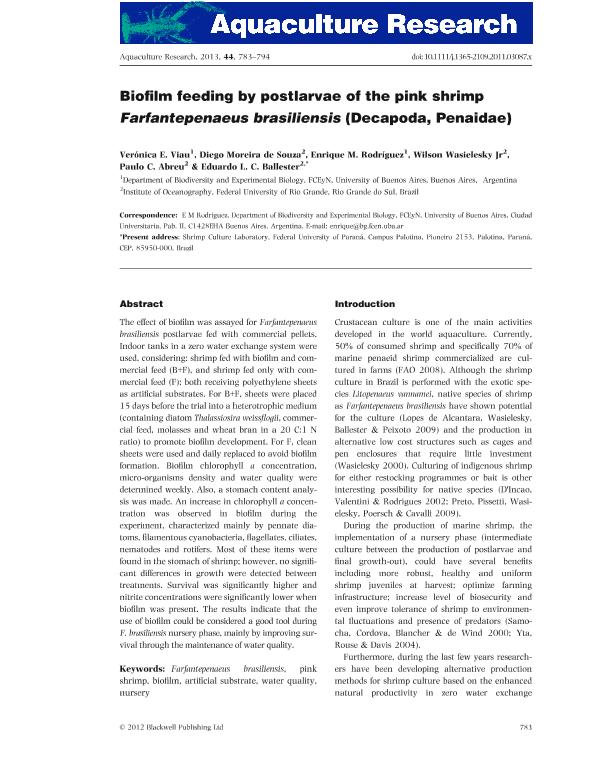Artículo
Biofilm feeding by postlarvae of the pink shrimp Farfantepenaeus brasiliensis (Decapoda, Penaidae)
Viau, Veronica Elizabeth ; Souza, Diego Moreira de; Rodriguez, Enrique Marcelo
; Souza, Diego Moreira de; Rodriguez, Enrique Marcelo ; Wasielesky Jr., Wilson; Abreu, Paulo C.; Ballester, Eduardo L. C.
; Wasielesky Jr., Wilson; Abreu, Paulo C.; Ballester, Eduardo L. C.
 ; Souza, Diego Moreira de; Rodriguez, Enrique Marcelo
; Souza, Diego Moreira de; Rodriguez, Enrique Marcelo ; Wasielesky Jr., Wilson; Abreu, Paulo C.; Ballester, Eduardo L. C.
; Wasielesky Jr., Wilson; Abreu, Paulo C.; Ballester, Eduardo L. C.
Fecha de publicación:
04/2013
Editorial:
Wiley
Revista:
Aquaculture Research
ISSN:
1355-557X
Idioma:
Inglés
Tipo de recurso:
Artículo publicado
Clasificación temática:
Resumen
The effect of biofilm was assayed for Farfantepenaeus brasiliensis postlarvae fed commercial pellets. Indoor tanks in a zero water exchange system were used, considering: shrimp fed with biofilm and commercial feed (B+F), and shrimp fed only with commercial feed (F); both receiving polyethylene sheets as artificial substrates. For B+F, sheets were placed 15 days before the trial into a heterotrophic medium(containing diatom Thalassiosira weissflogii, commercial feed, molasses and wheat bran in a 20 C:1 N ratio) to promote biofilm development. For F, clean sheets were used and daily replaced to avoid biofilm formation. Biofilm chlorophyll a concentration, micro-organisms density and water quality were determined weekly. Also, a stomach content analysis was made. An increase in chlorophyll a concentration was observed in biofilm during the experiment, characterized mainly by pennate diatoms, filamentous cyanobacteria, flagellates, ciliates, nematodes and rotifers. Most of these items were found in the stomach of shrimp; however, no signifi- cant differences in growth were detected between treatments. Survival was significantly higher and nitrite concentrations were significantly lower when biofilm was present. The results indicate that the use of biofilm could be considered a good tool during F. brasiliensis nursery phase, mainly by improving survival through the maintenance of water quality.
Palabras clave:
Farfantepenaeus Brasiliensis,
,
Pink Shrimp
,
Biofilm
,
Artificial Substrate,
Archivos asociados
Licencia
Identificadores
Colecciones
Articulos(OCA CIUDAD UNIVERSITARIA)
Articulos de OFICINA DE COORDINACION ADMINISTRATIVA CIUDAD UNIVERSITARIA
Articulos de OFICINA DE COORDINACION ADMINISTRATIVA CIUDAD UNIVERSITARIA
Citación
Viau, Veronica Elizabeth; Souza, Diego Moreira de; Rodriguez, Enrique Marcelo; Wasielesky Jr., Wilson; Abreu, Paulo C.; et al.; Biofilm feeding by postlarvae of the pink shrimp Farfantepenaeus brasiliensis (Decapoda, Penaidae); Wiley; Aquaculture Research; 44; 4-2013; 783-794
Compartir



